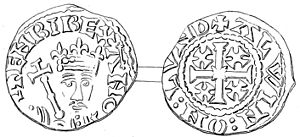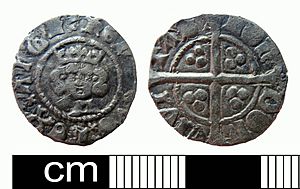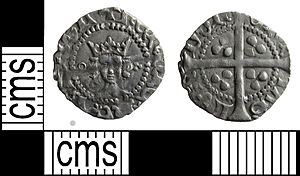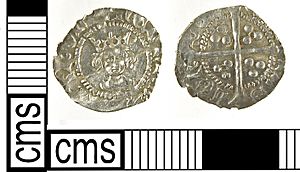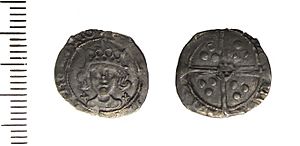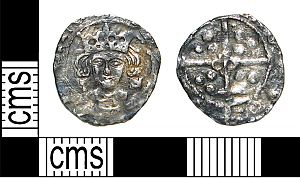History of the English penny (1154–1485) facts for kids
The history of the English penny from 1154 to 1485 tells the story of coins during the time of the House of Plantagenet kings. This period ended with the Battle of Bosworth Field, which started the Tudor period. During the Plantagenet era, the quality of English coins generally got better. However, fewer places called mints were used to make these coins.
When Henry II first became king, coins were made just like they were under King Stephen. Then, in 1158, the Tealby penny was introduced. These coins were made until 1180. They had good weight and silver quality, but they weren't made very well. Because of this, the short-cross penny was introduced in 1180.
Coins stayed mostly the same during the reigns of Richard I and King John. In 1247, under Henry III, the long-cross penny replaced the short-cross penny. This new design helped stop people from illegally cutting pieces off the coins, a practice called clipping. In 1279, Edward I started a new coinage system. His coins were so good that other countries copied them. He also introduced new coins like the farthing, halfpenny, and groat. These new coins also made clipping easier to spot. The coin designs stayed similar for Edward II and Edward III. Edward III also added gold coins: the quarter noble, half noble, and noble.
During the Wars of the Roses, Henry VI's government made sure there were enough coins. Many different designs of the penny were made. Henry was later overthrown by Edward IV. Edward V then became king, with Richard, Duke of Gloucester as his protector. Richard became king in 1483, but only a few coins were made in his name. He was defeated by Henry VII at the Battle of Bosworth Field in 1485.
Contents
Plantagenet Kings and Their Coins
Henry II's Coinage
Henry II became king in 1154. He was the first king from the Plantagenet family. For the first few years, coins from King Stephen were still made. But to make people trust the currency again, a new coin was introduced. This was the Tealby penny, named after a large group of these coins found in Tealby, Lincolnshire.
At first, 30 different mints (places where coins are made) were used to make these new coins. However, once enough coins were made, only 12 mints stayed open. This was the start of fewer mints being used to make English coins over time.
The Tealby coins were good in weight and silver quality. But they often looked poorly made. To fix this, a new coin called the short-cross penny was introduced in 1180. This design stayed almost the same until 1247. This helped make the coinage and the country feel stable. The name of the coin maker (called a moneyer) and the mint were still put on the back of the coin. With fewer mints, it was easier to check the quality of the coins.
Tealby coins had inscriptions like HENRI REX ANG or HENRI REX, meaning "Henry King of England" or "King Henry." Short-cross pennies were marked HENRICUS REX. These short-cross coins were made in places like London, York, and Winchester.
Richard I and John's Coins
During the reign of King Richard I (1189–1199), the short-cross coins continued to be made. They even kept the inscription HENRICUS REX, even though Richard was king. Richard's coins were made in places like London, Canterbury, and York.
King John's coins (1199–1216) also continued the short-cross series. They still said HENRICUS REX. John's coins were made in many places, including London, Canterbury, and York.
Henry III's Coinage Changes

King Henry III had a very long reign (1216–1272). The short-cross penny was used until 1247. By then, many coins in circulation were too light. This happened because people were illegally cutting silver off the edges of the coins. The cross on the back of the short-cross penny didn't go all the way to the edge, making it hard to see if a coin had been clipped.
So, in 1247, a new long-cross penny was introduced. This coin had a cross that went to the very edge, making it much easier to spot if it had been clipped. The rest of the design stayed mostly the same. The long cross also made it easy to cut the coin into halves or quarters for smaller change. To make enough new coins, many old mints had to be reopened.
Short-cross pennies for Henry III were made in London, York, and Canterbury. Long-cross pennies were made in many more places, including London, Bristol, and York.
The short-cross pennies still said HENRICUS REX. The long-cross pennies had different inscriptions like HENRICUS REX TERCI or HENRICUS REX III, meaning "King Henry the Third." Some coins even left out the moneyer's name.
Edward I's New Coins
Edward I (1272–1307) became king while he was away on a Crusade. Coin production had to continue while he traveled home. So, long-cross pennies with HENRICUS REX III were still made in some mints. As Edward returned, he saw the need for better English coins. He wanted to avoid the poor-quality coins that had sometimes appeared before.
There was also a need for bigger and smaller coin values. The penny had not changed much in 500 years. So, the groat (worth 4 pennies), halfpenny, and farthing were successfully introduced.
In 1279, a completely new coinage was made with a different design. This new design made clipping much easier to detect. Millions of coins were made in London and Canterbury. People could bring their old, underweight coins to the mint and exchange them for new, correct ones. This exchange also helped the government collect fees.
Edward's new coins were admired in Europe and often copied. But the copies were usually made with less pure silver. This made Edward's good-quality coins even more popular. So much so that in 1299, it became illegal to export English coins. These strong, good-quality coins helped the economy and brought wealth to the country.
The 1279 penny was different from earlier coins. The king's face looked more real and faced forward. The writing on the front was longer, usually EDW REX ANGL DNS HYB – "Edward King of England Lord of Ireland." The back had a long cross going to the edge of the coin. The moneyer's name was usually left out. Instead, the name of the mint was given in full, like CIVITAS LONDON "City of London." The new coins also had small hidden marks. These marks helped identify which moneyer made the coin, instead of using their name.
Edward II and Edward III Coins
Coins of Edward II (1307–1327) were made to look very similar to his father's coins. Edward I's coins were made in many places, including London, York, and Bristol. Edward II's coins were only made in Berwick, Bury St Edmunds, Canterbury, Durham, and London.
Edward III (1327–1377) became king at 14. His reign had many conflicts with Scotland and France, which affected his coins. At first, only a few pennies were made, similar to his father's. New gold coins were introduced: the noble, half noble, and quarter noble. Later, the silver groat (fourpence) became very popular and eventually more important than the penny. The half groat was also popular. With half pennies and farthings, England finally had enough different coin values. This helped trade both inside England and with other European countries.
Edward III's first coins (1327–1335) looked very much like Edward I and II pennies. They had EDWAR ANGL DNS HYB around the king's face. These pennies were made in London, York, and other places. No more pennies were made until his third coinage (1344–1351). In these coins, the king's hair looked longer. These coins were made in London, Canterbury, and York.
During Edward's fourth coinage (1351–1377), politics affected the coin inscriptions. Edward claimed the throne of France. After a peace treaty in 1360, he was given land in France. On some coins, but not the penny, his rule over Aquitaine was shown. When the French broke the treaty in 1369, the claim to France was brought back. England and France went to war again.
Richard II's Reign
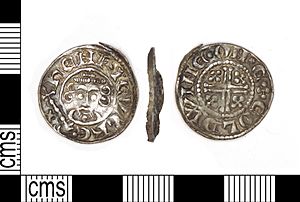
Edward III's son, the Black Prince, died in 1376. So, Edward's 11-year-old grandson, Richard II (1377–1399), became the next king. England still claimed France and was at war until 1396. High taxes to pay for the war caused several peasant uprisings.
During this time, many poor-quality European coins were used alongside the good English coins. This caused a problem: English coins were smuggled to Europe to be melted down. Then, they were mixed with other metals and made into fake pennies. These fake coins were then brought back to England. Pennies were made in London, York, and Durham. They had inscriptions like RICARDUS REX ANGLIE or RICARDUS REX ANGLE Z FRANC.
Lancastrian and Yorkist Coins
In 1399, Henry, Duke of Lancaster, overthrew his cousin Richard II. He became King Henry IV (1399–1413). This was a difficult time with wars in Scotland and Wales. The coin problems from the previous reign continued. Silver and gold were cheaper in England than in Europe. So, coins were illegally smuggled abroad. This caused big problems: there weren't enough coins in England, and the mints couldn't buy enough metal to make new ones.
Henry IV's pennies are divided into "heavy" coins (before 1412) and "light" coins (1412–13). The heavy coins had not been adjusted for the price of silver in Europe. The light coins had less silver to match the European price. This stopped the illegal export of English coins. Heavy coins were made in London and York, inscribed HENRIC DI GRA REX ANGL – "Henry by the Grace of God King of England." Light coins were made in London, York, and Durham, inscribed HENRIC REX ANGLIE.
Henry V (1413–1422) continued his father's light coinage. His coins had similar inscriptions and were made in London, Durham, and York.
Henry VI (1422–1461, 1470–1471) became king as a baby. He wanted peace with France. But his heir, Richard, Duke of York, wanted war. This disagreement started the Wars of the Roses between Henry's supporters (Lancastrians, red rose) and Richard's (Yorkists, white rose).
In 1461, Henry was defeated by Richard's son, who became King Edward IV. Henry was put in the Tower of London. The wars continued, and in 1470, Edward had to flee. Henry was put back on the throne for a short time. But Edward gathered more support and returned to the throne in 1471. Henry was sent back to the Tower and was murdered that night.
Despite these troubled times, Henry VI's government kept enough coins in circulation during his first reign. There were several different penny designs. They had features like rosettes or pinecones in the writing, or a leaf on the king's chest. The usual inscription was HENRICUS REX ANGLIE. Pennies were made in London, Calais, York, and Durham.
During Edward IV's first reign, the problem of English coins being worth less in Europe than in England came back. In 1464, Edward solved this by reducing the weight of all silver coins by about 20%. The "heavy" penny (1461–1464) weighed 15 grains (1.0 gram) and was made in London, York, and Durham. The "light" penny weighed 12 grains (0.8 gram) and was made in London, Bristol, Canterbury, Durham, and York. All were inscribed EDWARD DI GRA REX ANGL.
Even though Henry VI's second reign was short, pennies were made in a similar style to his first reign. Edward IV's second reign pennies were similar to his first. By this time, all kings used mintmarks on their coins to identify the moneyers.
Edward IV died suddenly in 1483. His 12-year-old son, Edward V, became king. But there were questions about whether Edward IV's marriage was legal. So, Parliament removed Edward V from the throne. They made Edward IV's brother, Richard, Duke of Gloucester, King Richard III. Edward V and his younger brother were taken to the Tower of London and were never seen again. What happened to them is still a mystery. It's thought some coins were made for King Edward V, but none are known to exist today.
Richard III (1483–1485) was the last Plantagenet king. Before he was defeated at the Battle of Bosworth Field, pennies were made for him. They were inscribed RICARD DEI GRA REX ANGL. These coins were made in London, York, and Durham, but they are very rare. Only one penny from the London mint is known to exist.
Images for kids


